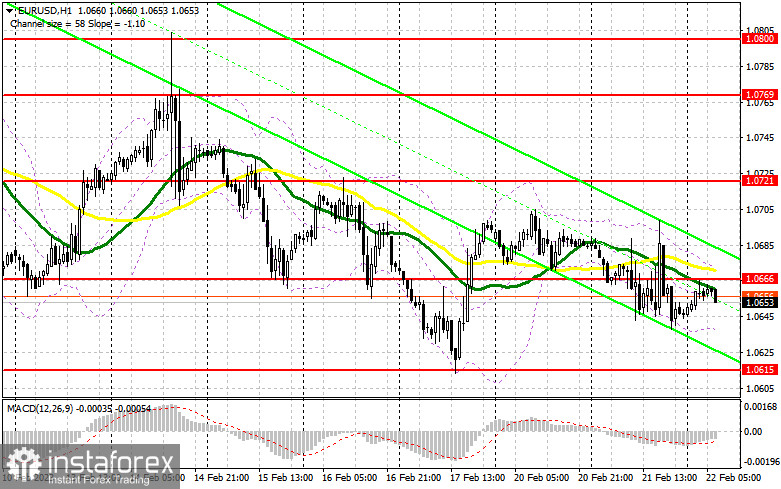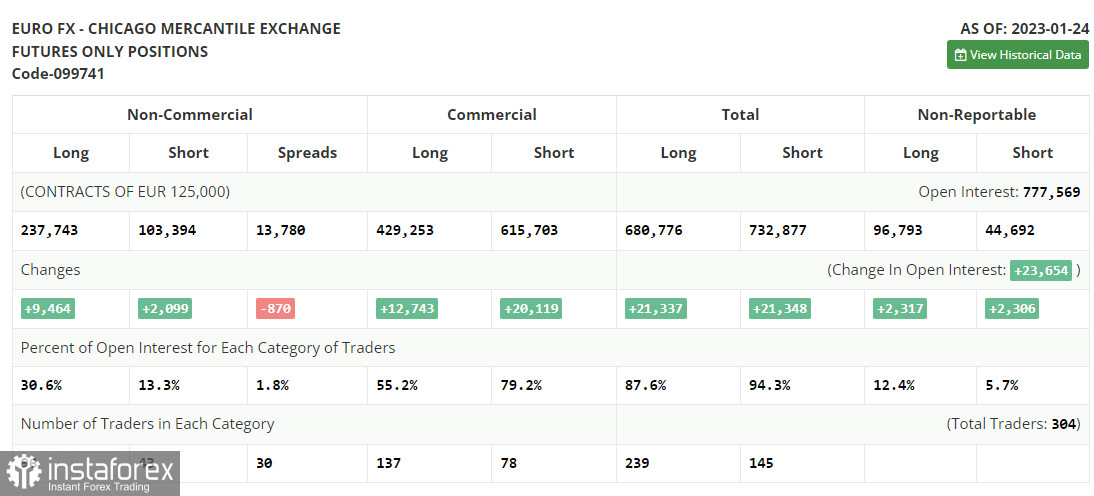Yesterday, traders received several signals to enter the market. Let us take a look at the 5-minute chart to figure out what happened. Earlier, I asked you to pay attention to the level of 1.0664 to decide when to enter the market. A decline and a false breakout of this level led to a good buy signal, which allowed the pair to add 20 pips. However, the eurozone PMI data failed to support buyers. As a result, the pair did not show a considerable rise. In the second part of the day, a return below 1.0677 and an upward test of the level gave a sell signal. As a result, the pair dropped by more than 30 pips.

Conditions for opening long positions on EUR/USD:
Yesterday, in the second part of the day, strong data on the US PMI exerted pressure on the euro, thus allowing the greenback to gain in value. Today, bulls may also face obstacles if strong data from Germany does not cause a market reaction. Thus, Germany will disclose its CPI data for January. A rapid rise in inflation should support the euro. Reports on Germany's business climate, current assessment, and economic expectations prepared by the Ifo Institute may also boost the single currency. If a reaction to the data is negative, it is better to avoid buying the asset until it reaches the nearest support level of 1.0615. Only a false breakout of this level will give a buy signal with the target at the resistance level of 1.0666. The currency is now trading near this level. There, we can also see MAs. A breakout and a downward test of 1.0666 amid strong data from the eurozone will give an additional buy signal with the target at 1.0721. However, the price will hardly exceed this level today. It will be possible only after the publication of the Fed meeting minutes. This movement will affect bears' stop orders, thus providing traders with one more buy signal with the target at 1.0769, where it is better to lock in profits. If the euro/dollar pair declines and buyers fail to protect 1.01615 in the first part of the day, the pair will remain under pressure. A breakout of the level will intensify the bearish trend. In the event of this, traders will focus on the next support level of 1.0565. Only a false breakout of this level will give a buy signal. Traders may go long just after a bounce off the low of 1.0525 or even lower – from 1.0484, expecting a rise of 30-35 pips intraday.
Conditions for opening short positions on EUR/USD:
Traders may go short at 1.0666. However, bears should be quite aggressive at this level in the first part of the day, especially after the publication of positive data in the eurozone. Weak data will attract more big traders, who will bet on a decline in risk assets ahead of the key rate hike by the Fed. A false breakout of 1.0666 will give a sell signal. In this case, the price may slump to 1.0615. A breakout and a reverse test will form a new sell signal with the target at 1.0565, which will intensify bearish sentiment. A settlement below this area will cause a more noticeable decline to 1.0525, where it will be wise to lock in profits. If the euro/dollar pair increases during the European session and bears fail to protect 1.0666, bulls will make an attempt to return to the market. In this light, it is better to avoid selling until the price touches 1.0721. There, traders may go short only after an unsuccessful settlement. It is also possible to open sell orders at the high of 1.0769, expecting a drop of 30-35 pips.

COT report
Since a technical problem in the CFTC has been settled yet. The latest COT report was published on January 24. Thus, the COT report for January 24 logged a rise in both short and long positions. Traders have significantly increased long positions following hawkish speeches of ECB policymakers. They are betting on further monetary tightening by the ECB and the Fed's dovish stance. The US regulator may reduce the pace of tightening for the second time in a row. Weak macro stats on the US economy, namely a drop in retail sales and a slowdown in inflation may force the central bank to take a pause in rate hikes to avoid any damage. This week, several central banks will hold their meetings. Their results will eventually determine the trajectory of the euro/dollar pair. According to the COT report, the number of long positions of the non-commercial group of traders increased by 9,464 to 237,743 while short positions advanced by 2,099 to 103,394. At the end of the week, the total non-commercial net position rose to 134,349 from 126,984. It appears investors believe in the upside potential of the euro. Nevertheless, they are waiting for more clues from central banks regarding interest rates. The weekly closing price grew to 1.0919 from 1.0833.

Signals of indicators:
Moving Averages
Trading is performed near 30- and 50-day moving averages, which points to sideways movement.
Note: The author considers the period and prices of moving averages on the one-hour chart which differs from the general definition of the classic daily moving averages on the daily chart.
Bollinger Bands
If the pair increases, the resistance level will be formed by the upper limit of the indicator located at 1.0670. In case of a decline, the lower limit of the indicator located at 1.0635 will act as support.
Description of indicators
- Moving average (a moving average determines the current trend by smoothing volatility and noise). The period is 50. It is marked in yellow on the chart.
- Moving average (a moving average determines the current trend by smoothing volatility and noise). The period is 30. It is marked in green on the graph.
- MACD indicator (Moving Average Convergence/Divergence - convergence/divergence of moving averages). A fast EMA period is 12. A slow EMA period is 26. The SMA period is 9.
- Bollinger Bands. The period is 20.
- Non-profit speculative traders are individual traders, hedge funds, and large institutions that use the futures market for speculative purposes and meet certain requirements.
- Long non-commercial positions are the total number of long positions opened by non-commercial traders.
- Short non-commercial positions are the total number of short positions opened by non-commercial traders.
- The total non-commercial net position is a difference in the number of short and long positions opened by non-commercial traders.
 English
English 
 Русский
Русский Bahasa Indonesia
Bahasa Indonesia Bahasa Malay
Bahasa Malay ไทย
ไทย Español
Español Deutsch
Deutsch Български
Български Français
Français Tiếng Việt
Tiếng Việt 中文
中文 বাংলা
বাংলা हिन्दी
हिन्दी Čeština
Čeština Українська
Українська Română
Română

